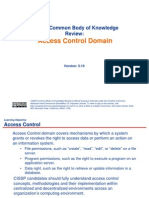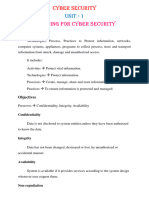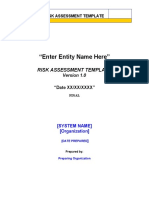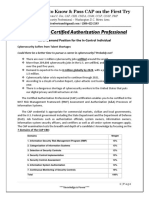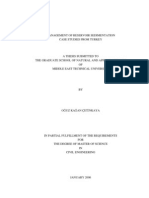0 ratings0% found this document useful (0 votes)
Categorization: Categorize The Information System
Categorization: Categorize The Information System
Uploaded by
TKThe document discusses the categorization process for information systems which includes documenting system characteristics, identifying information types, selecting provisional impact levels, reviewing and finalizing impact levels, assigning a system security category, reviewing and approving the security categorization, developing a system security plan, and maintaining the categorization over the system lifecycle. The purpose is to inform risk management by determining the adverse impacts of loss of confidentiality, integrity and availability.
Copyright:
© All Rights Reserved
Available Formats
Download as PPTX, PDF, TXT or read online from Scribd
Download as pptx, pdf, or txt
Categorization: Categorize The Information System
Categorization: Categorize The Information System
Uploaded by
TK0 ratings0% found this document useful (0 votes)
The document discusses the categorization process for information systems which includes documenting system characteristics, identifying information types, selecting provisional impact levels, reviewing and finalizing impact levels, assigning a system security category, reviewing and approving the security categorization, developing a system security plan, and maintaining the categorization over the system lifecycle. The purpose is to inform risk management by determining the adverse impacts of loss of confidentiality, integrity and availability.
Original Title
CATEGORIZATION
Copyright
© © All Rights Reserved
Available Formats
PPTX, PDF, TXT or read online from Scribd
Share this document
Did you find this document useful?
Is this content inappropriate?
The document discusses the categorization process for information systems which includes documenting system characteristics, identifying information types, selecting provisional impact levels, reviewing and finalizing impact levels, assigning a system security category, reviewing and approving the security categorization, developing a system security plan, and maintaining the categorization over the system lifecycle. The purpose is to inform risk management by determining the adverse impacts of loss of confidentiality, integrity and availability.
Copyright:
© All Rights Reserved
Available Formats
Download as PPTX, PDF, TXT or read online from Scribd
Download as pptx, pdf, or txt
0 ratings0% found this document useful (0 votes)
Categorization: Categorize The Information System
Categorization: Categorize The Information System
Uploaded by
TKThe document discusses the categorization process for information systems which includes documenting system characteristics, identifying information types, selecting provisional impact levels, reviewing and finalizing impact levels, assigning a system security category, reviewing and approving the security categorization, developing a system security plan, and maintaining the categorization over the system lifecycle. The purpose is to inform risk management by determining the adverse impacts of loss of confidentiality, integrity and availability.
Copyright:
© All Rights Reserved
Available Formats
Download as PPTX, PDF, TXT or read online from Scribd
Download as pptx, pdf, or txt
You are on page 1/ 22
CATEGORIZATION
CATEGORIZE THE INFORMATION SYSTEM
PURPOSE
The purpose of the Categorize step is to inform organizational risk
management processes and tasks by determining the adverse impact to
organizational operations and assets, individuals, other organizations, and
the Nation with respect to the loss of confidentiality, integrity, and
availability of organizational systems and the information processed, stored,
and transmitted by those systems.
SYSTEM DESCRIPTION
• TASK C-1 Document the characteristics of the system.
• Primary Responsibility: Information System owner
• SDLC: Initiation
• References: SP 800-18
Discussion
• A description of the system characteristics is documented in the security and
privacy plans, included in attachments to the plans, or referenced in other
standard sources for the information generated as part of the SDLC.
• The level of detail in the security and privacy plans is determined by the
organization and is commensurate with the security categorization and the
security and privacy risk assessments of the system. Information may be added
to or updated in the system description as it becomes available during the
system life cycle, during the execution of the RMF steps, and as any system
characteristics change.
Discussion Con’t
Examples of different types of descriptive information that organizations can include in security and privacy plans
include:
Full descriptive name of the information system including any associated acronym
Unique information system identifier
Hardware and firmware devices included within the information system
Location of the information system and environment in which the system operates
System version or release number;
Manufacturer and supplier information;
Individual responsible for the system;
System contact information etc.
Security Categorization
TASK C-2: Categorize the system and document the security categorization
results.
Primary Responsibility: System Owner; Information Owner or Steward.
SDLC Phase: New – Initiation (concept/requirements definition). Existing –
Operations/Maintenance.
References: FIPS 199; FIPS 200; SP 800-30; SP 800-60 v1; SP 800-60 v2
Categorization Process Con’t
• Sensitivity- Measures the importance assigned to information by its owner
for the purpose of denoting its need for protection. It is related to the data
that resides within an information system
• Criticality: Measures the degree to which an organization depends on the
information or information system for the success of a mission or of a
business function. It is related to the entire information system
Categorization Process Step 1 (Identify
Information Types)
Identify Information Types Step 1 NIST SP
800-60 Vol. 1&2
• The first step in the security categorization process is identify the types of
information the system will receive. store, process or disseminate.
• This is the primary responsibility of the information owners and the
system owner.
• It is very important to have a thorough understanding of the purpose and
intended use of the information system. E.g. Mission Critical System,
Sensitive data, Financial data, Health or administrative data etc.
Identifying Information type Step 3: Select
Provisional Impact level
• Select the security impact levels for the identified information types.
• Determine the security category (SC) for each information type:
SC information type ={(confidentiality, impact), (integrity, impact),
(availability, impact)}
• Document the provisional impact level of confidentiality, integrity, and
availability associated with the system’s information type
Identifying Information type Step 3: Review
Provisional Impact Levels and Adjust/Finalize
Information Type Impact Levels
• Review the appropriateness of the provisional impact levels based on the
organization, environment, mission, use, and data sharing
• Adjust the impact levels as necessary based on the following considerations: - -
Confidentiality, integrity, and availability factors
- Situational and operational drivers (timing, lifecycle, etc.)
- Legal or statutory reasons
• Document all adjustments to the impact levels and provide the rationale or
justification for the adjustments
Identifying Information type Step 4: Assign
System Security Category
• Review identified security categorizations for the aggregate of information types.
• Determine the system security categorization by identifying the security impact level high
water mark for each of the security objectives (confidentiality, integrity, availability)
• Adjust the security impact level high water mark for each system security objective, as
necessary
• Assign the overall information system impact level based on the highest impact level for the
system security objectives (confidentiality, integrity, availability)
• Follow the agency’s oversight process for reviewing, approving, and documenting all
determinations or decisions
Example 1
Information Type:
An organization managing public information on its web server determines
that there is no potential impact from a loss of confidentiality, a moderate
potential impact from the loss of integrity, and a moderate potential impact
from a loss of availability.
The resulting security category, SC, of this information type is expressed as
SC-public information= {(confidentiality, L), (integrity, M), (availability,
M))
Example 2
Information Type
A law enforcement organization managing extremely sensitive investigation
information determines that the potential impact from a loss of
confidentiality is high, the potential impact from the loss of integrity is
moderate, and the potential impact from the loss of availability is moderate.
The resulting security category, SC, of this information type is expressed as
SC-public information= {(confidentiality, H), (integrity, M), (availability,
M))
SECURITY CATEGORIZATION REVIEW
AND APPROVAL
TASK C-3 Review and approve the security categorization results and
decision.
Primary Responsibility: Authorizing Official or Authorizing Official
Designated Representative; Senior Agency Official for Privacy.
SDLC Phase: New – Initiation (concept/requirements definition).
References: FIPS 199; SP 800-30; SP 800-39
Discussion
• For information systems that process PII, the senior agency official for
privacy reviews and approves the security categorization results and
decision prior to the authorizing official’s review.
• Security categorization results and decisions are reviewed by the
authorizing official or a designated representative to ensure that the
security category selected for the information system is consistent with the
mission and business functions of the organization and the need to
adequately protect those missions and functions.
System Security Plan; NIST SP 800-18
The main purpose of the SSP is to fully describe the
security posture of an information system, including
providing a comprehensive listing of all controls
selected for the system, i.e., describe the controls in
place or planned for meeting security requirements
for the information system.
SSP Con’t
• The System Owner is responsible for the plan, but it can be delegated to the ISSO.
• SSP Contents:
- System Description – Categorization
- Description of Controls
- System Security Roles and Responsibilities
- System Operational Status and System Types
- System Environment
- System Interconnection and Sharing
- Rules of Behavior
- Completion and Approval Dates
System Security Plan Cont’d
• Plan Approval
- The System Owner constructs and approve the initial system security plan for
the system and sends for independent review.
- The plan is reviewed and approved independently through the Approving
Official or Designated Representative.
- The final SSP is approved by the Approving Official or Designated
Representative.
- This normally a collaborative back-and forth relationship where controls are
negotiated
System Security Plan Cont’d
• Plan Maintenance
- The SSP is a living document and should be kept up to date
- It should be reviewed annually at a minimum
- It should be aligned with organization policy revision and change
management processes
- Since the SSP document the security specification of the system, the plan
should be safeguarded and give the appropriate classification.
Categorize Process Review
The categorize process includes the following tasks
-Document the characteristics of the system.
- Identify the system’s information types
- Select the impact value for each information type
- Adjust the information type’s impact value
- Adjust the system’s security category
- Determine the information system’s security impact level
- Obtain approval for the system security category and impact level
- Maintain system security category and impact level
Categorize Process Review
• Input Include
- System description, including system boundary
- Enterprise architecture
- Information types from 800-60, Vol. 1 & 2
Output Includes
- Security category for each information type
- Information system security category and high-water mark
- Reasoning for any adjustments
You might also like
- CCNP Security Identity Management SISE 300-715 Official Cert Guide67% (3)CCNP Security Identity Management SISE 300-715 Official Cert Guide1,190 pages
- Information Security Governance & Risk Management70% (10)Information Security Governance & Risk Management37 pages
- Risk Management Framework Whitepaper Module 7No ratings yetRisk Management Framework Whitepaper Module 79 pages
- Operationalizing Information Security: Putting the Top 10 SIEM Best Practices to WorkFrom EverandOperationalizing Information Security: Putting the Top 10 SIEM Best Practices to WorkNo ratings yet
- Aspect Medical BIS Vista Monitoring System - Service ManualNo ratings yetAspect Medical BIS Vista Monitoring System - Service Manual94 pages
- Assignment - Comparison and Contrast On TCSEC, CC, SSE-CMM and ISO27001100% (1)Assignment - Comparison and Contrast On TCSEC, CC, SSE-CMM and ISO270015 pages
- Topic & Reference Sam NIST 800-53 Hipaa: Risk Assessment Reference ChartNo ratings yetTopic & Reference Sam NIST 800-53 Hipaa: Risk Assessment Reference Chart9 pages
- Security Plan: Presented To Spirit For The Wic Spirit Automation Project May 19, 2005No ratings yetSecurity Plan: Presented To Spirit For The Wic Spirit Automation Project May 19, 200515 pages
- ISM - Using the Information Security Manual (March 2023)No ratings yetISM - Using the Information Security Manual (March 2023)4 pages
- Types of IT Audits: Information Security (Module-1)No ratings yetTypes of IT Audits: Information Security (Module-1)30 pages
- Enc Encoded e98S8lOAvMZodtyNxZz36hP3TqBPq GmZzXzKaByfmO4qgVvc9Z6ZdlBhfq1obn6QwNo ratings yetEnc Encoded e98S8lOAvMZodtyNxZz36hP3TqBPq GmZzXzKaByfmO4qgVvc9Z6ZdlBhfq1obn6Qw34 pages
- The National Institute of Standards and TechnologyNo ratings yetThe National Institute of Standards and Technology3 pages
- Complying With The Federal Information Security Act (Fisma)No ratings yetComplying With The Federal Information Security Act (Fisma)19 pages
- ISM - Guidelines For Security Documentation (MAY19)No ratings yetISM - Guidelines For Security Documentation (MAY19)3 pages
- Day 3 Session 1-Secure Software RequirementsNo ratings yetDay 3 Session 1-Secure Software Requirements32 pages
- Structured System Analysis and Design (BIT321) System Security and AuditNo ratings yetStructured System Analysis and Design (BIT321) System Security and Audit18 pages
- UNIT 7 - IT Security Management Risk Assessment Security Auditing5 HrsNo ratings yetUNIT 7 - IT Security Management Risk Assessment Security Auditing5 Hrs5 pages
- COE 456 Secure Network Systems: Lecture 2: Risk Management (Part I) : Identifying and Assessing RiskNo ratings yetCOE 456 Secure Network Systems: Lecture 2: Risk Management (Part I) : Identifying and Assessing Risk44 pages
- "Enter Entity Name Here": Risk Assessment TemplateNo ratings yet"Enter Entity Name Here": Risk Assessment Template35 pages
- ISO 27001 Fundamental Concepts: Presented by John LaffeyNo ratings yetISO 27001 Fundamental Concepts: Presented by John Laffey23 pages
- Week 3 - NIST Risk Management FrameworkNo ratings yetWeek 3 - NIST Risk Management Framework25 pages
- Performing A Risk Assessment 3e - Paul Shenjere MutiswaNo ratings yetPerforming A Risk Assessment 3e - Paul Shenjere Mutiswa8 pages
- Authorizing Official Handbook: for Risk Management Framework (RMF)From EverandAuthorizing Official Handbook: for Risk Management Framework (RMF)No ratings yet
- Understanding Basic Security Terms and ConceptsNo ratings yetUnderstanding Basic Security Terms and Concepts35 pages
- Oracle Actualtests 1z0-071 v2020-05-27 by Finn 212qNo ratings yetOracle Actualtests 1z0-071 v2020-05-27 by Finn 212q161 pages
- Risk Management - Overview, Importance and ProcessesNo ratings yetRisk Management - Overview, Importance and Processes5 pages
- Tributo A Queen Choir & Piano Extractada PDFNo ratings yetTributo A Queen Choir & Piano Extractada PDF17 pages
- Complete Accounting For Government Disbursements100% (1)Complete Accounting For Government Disbursements127 pages
- Siemens Air Cooled Generators Sgen 100a 4p Brochure PDFNo ratings yetSiemens Air Cooled Generators Sgen 100a 4p Brochure PDF4 pages
- Module TLS.2 The TLS/SSL Protocol TLS MITM AttackNo ratings yetModule TLS.2 The TLS/SSL Protocol TLS MITM Attack14 pages
- Lecture 21 - Solution of The Generalized Eigenvalue ProblemNo ratings yetLecture 21 - Solution of The Generalized Eigenvalue Problem4 pages
- Arch't. Garry M. Advento, MPA: - / - Recommending Approval / DateNo ratings yetArch't. Garry M. Advento, MPA: - / - Recommending Approval / Date2 pages
- Labview Core 2 Instructor Guide: November 2014No ratings yetLabview Core 2 Instructor Guide: November 201453 pages
- Assignment On Evolution and MGT Thought Updated100% (1)Assignment On Evolution and MGT Thought Updated57 pages
- Facebook Post For "YCRA English Langue Club"No ratings yetFacebook Post For "YCRA English Langue Club"3 pages
- Management of Reservoir Sedimentation - TurkeyNo ratings yetManagement of Reservoir Sedimentation - Turkey210 pages
- CCNP Security Identity Management SISE 300-715 Official Cert GuideCCNP Security Identity Management SISE 300-715 Official Cert Guide
- Operationalizing Information Security: Putting the Top 10 SIEM Best Practices to WorkFrom EverandOperationalizing Information Security: Putting the Top 10 SIEM Best Practices to Work
- Aspect Medical BIS Vista Monitoring System - Service ManualAspect Medical BIS Vista Monitoring System - Service Manual
- Assignment - Comparison and Contrast On TCSEC, CC, SSE-CMM and ISO27001Assignment - Comparison and Contrast On TCSEC, CC, SSE-CMM and ISO27001
- Topic & Reference Sam NIST 800-53 Hipaa: Risk Assessment Reference ChartTopic & Reference Sam NIST 800-53 Hipaa: Risk Assessment Reference Chart
- Security Plan: Presented To Spirit For The Wic Spirit Automation Project May 19, 2005Security Plan: Presented To Spirit For The Wic Spirit Automation Project May 19, 2005
- ISM - Using the Information Security Manual (March 2023)ISM - Using the Information Security Manual (March 2023)
- Types of IT Audits: Information Security (Module-1)Types of IT Audits: Information Security (Module-1)
- Enc Encoded e98S8lOAvMZodtyNxZz36hP3TqBPq GmZzXzKaByfmO4qgVvc9Z6ZdlBhfq1obn6QwEnc Encoded e98S8lOAvMZodtyNxZz36hP3TqBPq GmZzXzKaByfmO4qgVvc9Z6ZdlBhfq1obn6Qw
- The National Institute of Standards and TechnologyThe National Institute of Standards and Technology
- Complying With The Federal Information Security Act (Fisma)Complying With The Federal Information Security Act (Fisma)
- ISM - Guidelines For Security Documentation (MAY19)ISM - Guidelines For Security Documentation (MAY19)
- Structured System Analysis and Design (BIT321) System Security and AuditStructured System Analysis and Design (BIT321) System Security and Audit
- UNIT 7 - IT Security Management Risk Assessment Security Auditing5 HrsUNIT 7 - IT Security Management Risk Assessment Security Auditing5 Hrs
- COE 456 Secure Network Systems: Lecture 2: Risk Management (Part I) : Identifying and Assessing RiskCOE 456 Secure Network Systems: Lecture 2: Risk Management (Part I) : Identifying and Assessing Risk
- "Enter Entity Name Here": Risk Assessment Template"Enter Entity Name Here": Risk Assessment Template
- ISO 27001 Fundamental Concepts: Presented by John LaffeyISO 27001 Fundamental Concepts: Presented by John Laffey
- Performing A Risk Assessment 3e - Paul Shenjere MutiswaPerforming A Risk Assessment 3e - Paul Shenjere Mutiswa
- Authorizing Official Handbook: for Risk Management Framework (RMF)From EverandAuthorizing Official Handbook: for Risk Management Framework (RMF)
- Oracle Actualtests 1z0-071 v2020-05-27 by Finn 212qOracle Actualtests 1z0-071 v2020-05-27 by Finn 212q
- Risk Management - Overview, Importance and ProcessesRisk Management - Overview, Importance and Processes
- Siemens Air Cooled Generators Sgen 100a 4p Brochure PDFSiemens Air Cooled Generators Sgen 100a 4p Brochure PDF
- Lecture 21 - Solution of The Generalized Eigenvalue ProblemLecture 21 - Solution of The Generalized Eigenvalue Problem
- Arch't. Garry M. Advento, MPA: - / - Recommending Approval / DateArch't. Garry M. Advento, MPA: - / - Recommending Approval / Date












